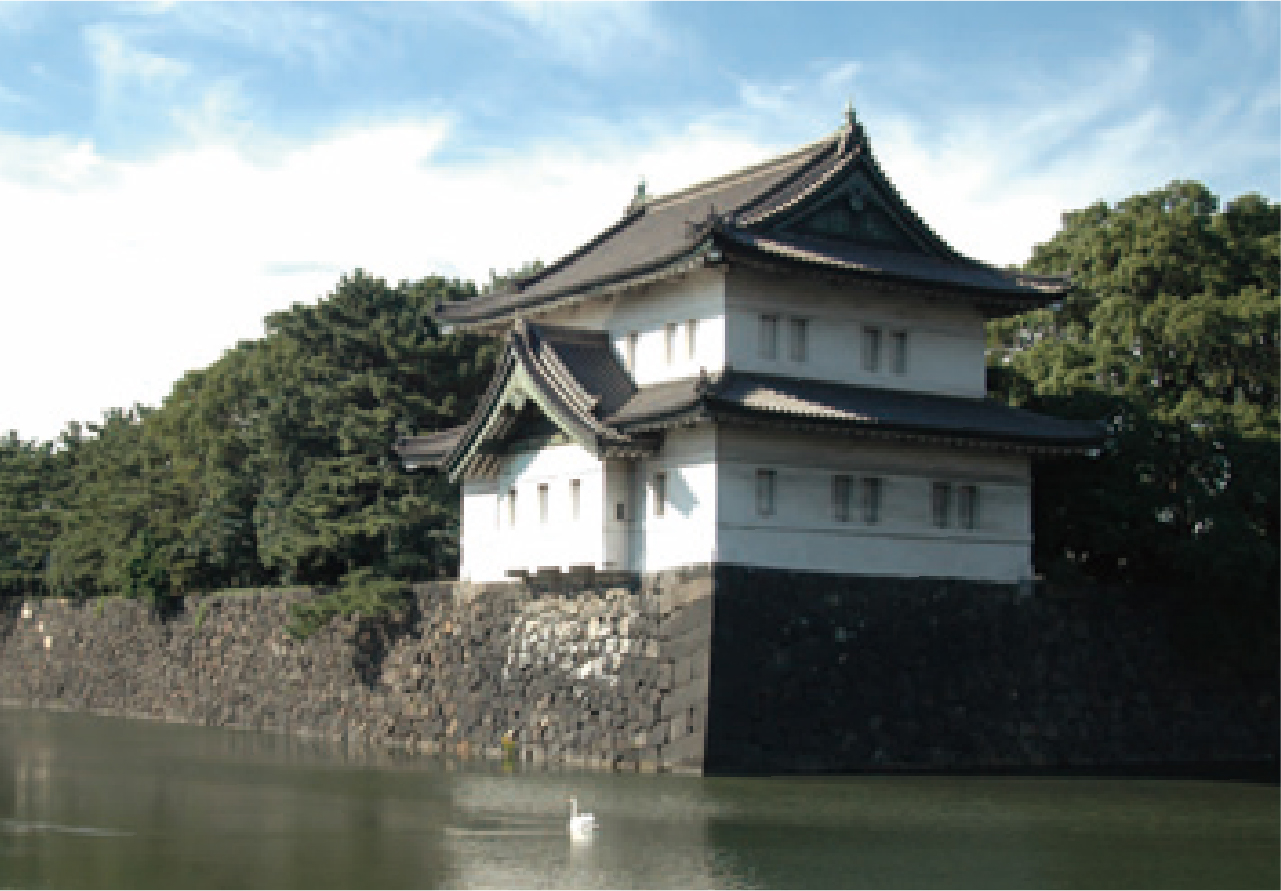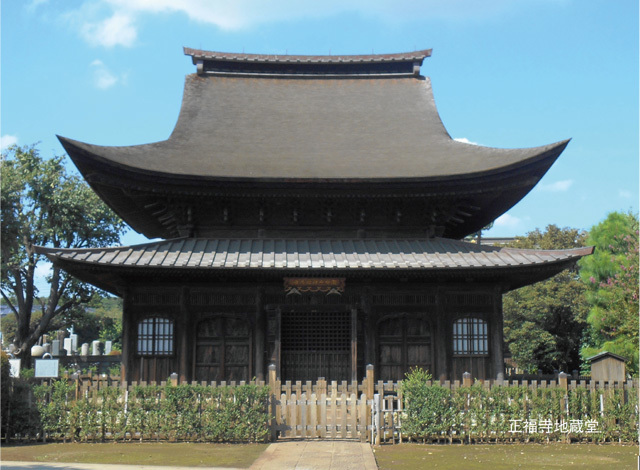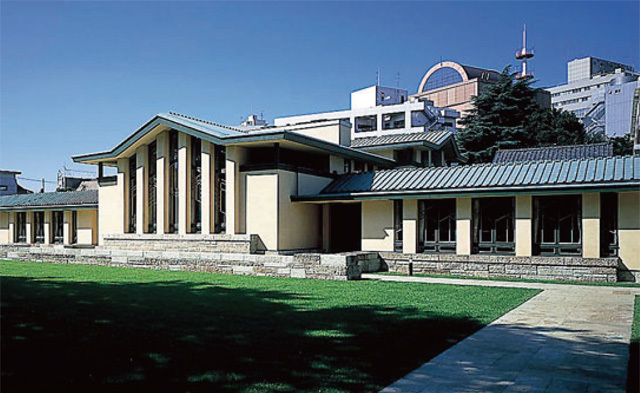
Let's take a stroll around The places associated with Shinsengumi!
The places associated with Shinsengumi (Hino, Chohu, Mitaka, Fuchu, Machida)
Shinsengumi showed its striking presence in Kyoto or in the Boshin War at the end of Edo period. Although we are impressed with their efforts in Kyoto, Tama region has also many places which are associated with Shinsengumi. Some of them are designated for Cultural properties.
This route is selected to get familiar with Shinsengumi visiting several Cultural properties. Let's enjoy this tour of Cultural properties with thought of turbulent times.
Shinsengumi
Shinsengumi was active in Kyoto at the end of Edo period, and fought it out in the Boshin War as the Former Shogunate Army. It has been appeared many times in novels including "Moeyo Ken" by SHIBA Ryotaro, movies and TV dramas. And recently, animations, games and comics featuring Shinsengumi make a great hit.
KONDO Isami and his comrade of Tennenrishin-ryu School (school of swordplay), HIJIKATA Toshizo and INOUE Genzaburo in Hino organized Shinsengumi, and became leading members of it. Menaces from foreign countries, domestic market disturbances by opening of the country to the world, the idea of Sonno-Joi (slogan advocating reverence for the Emperor and the expulsion of foreigners) gained momentum..., under these social conditions, they joined the Roshigumi which was organized by Shogunate for guarding the 14th Shogun, TOKUGAWA Iemochi on the way to Kyoto.
Although many Roshi (masterless samurai) returned to Edo for operating the anti-foreigner policy, KONDO Isami and his comrade remained and applied for a job of guarding Kyoto City to the lord of Aizu Domain, MATSUDAIRA Katamori in the Kyoto Shugoshoku post (the deputy of Kyoto) for guarding Kyoto City. It is well known that they were named Shinsengumi with success in the Coup of August 18 in 1863 and gained fames in Ikedaya Incident etc.
After Taisei Hokan (Returning the power to the Emperor) on October and Oseifukko-no-Daigorei (restoring the Imperial rule) on December in 1867, the Boshin War occurred between the Former Shogunate Army and the New Government's Forces, which lasted nearly one and a half year. After being defeated in the Battle of Toba-Fushimi, they continued to fight as volunteer group of Former Shogunate. However, on April in 1868 KONDO Isami surrendered to the New Government's Army at Nagareyama and was decapitated at Itabashi, while HIJIKATA Toshizo who participated the Hakodate Government by Former Shogunate, and he was killed in the all-out assault of Hakodate.
Shinsengumi which ran through the times of the turbulence called the late TOKUGAWA period, and the revolution, most of them lost their life in the battle. However their way of life that sacrificed itself for loyalty to the Shogunate still attracts many people.

The Battle of Toba-Fushimi
Walking Course Highlights / Hino city
Walking Course Highlights / Chohu city, Mitaka city
Walking Course Highlights / Fuchu city
Walking Course Highlights / Machida city
Route Map
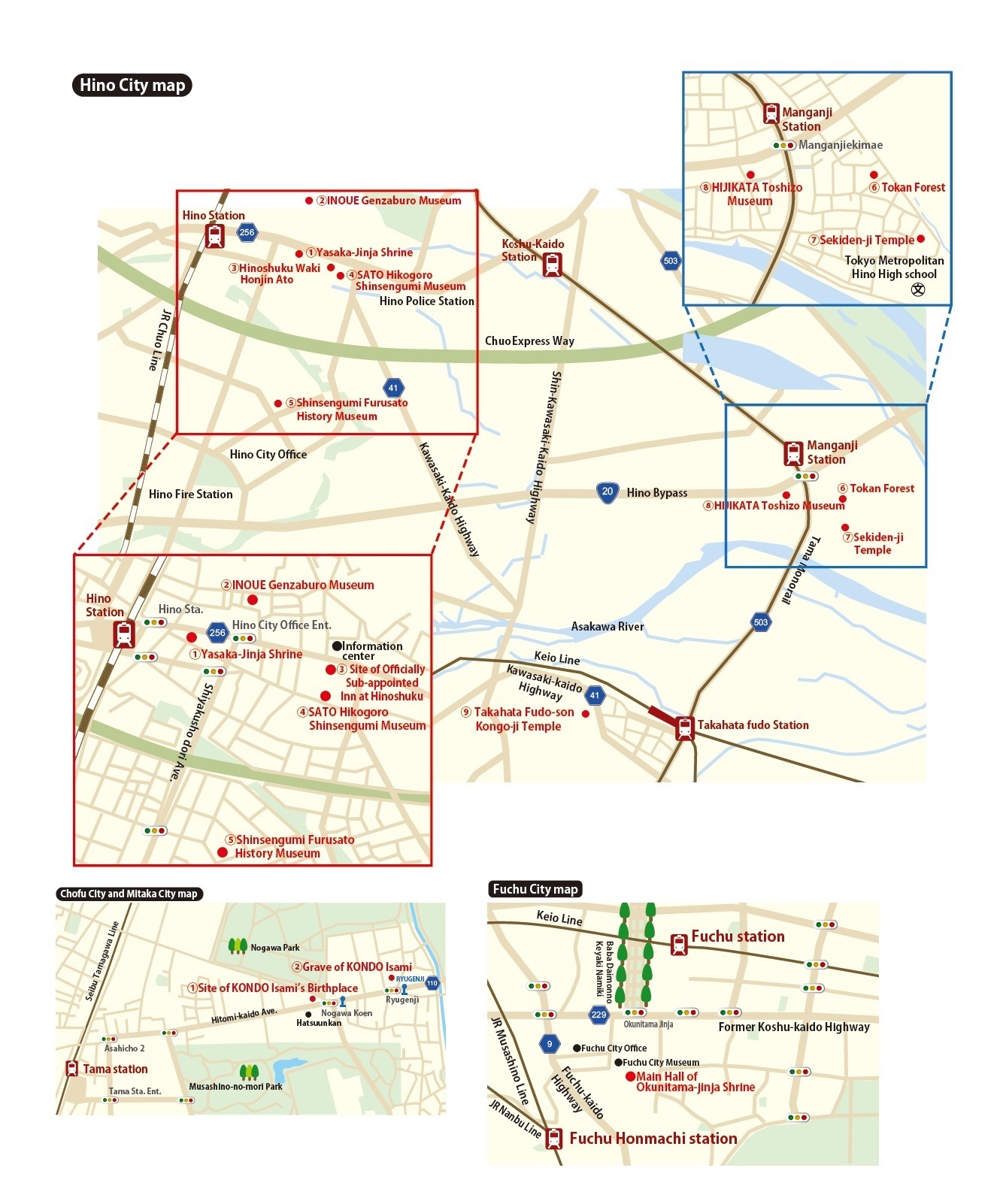

Brochure (PDF)
Hino city Course (Let's take a stroll around The places associated with Shinsengumi !)
Memories of Shinsengumi in Hino City
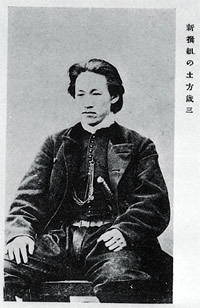
HIJIKATA Toshizo (Courtesy of National Diet Library)
The vice chief of Shinsengumi, HIJIKATA Toshizo and the leader of the Rokubantai, INOUE Genzaburo, were born and grown up in current Hino City. HIJIKATA Toshizo was descended from the family of "Daijin" (provincial magnate) for generations in Ishidamura Village, Musashi Country, (current Ishida, Hino City). He recieved Kenjutsu (swordplay) training at the school of SATO Hikogoro, who was his brother-in-law.
INOUE Genzaburo was born to the INOUE Family of Hachioji Sennin Doshin (junior officials in Hachioji) at Hinoshuku (Hino Post Town), Kitahara, and with his elder brother Matsugoro joined the Tennenrishin-ryu School. OKITA Soji who was related to INOUE Family spent certain days at Hinoshuku.
Hinoshuku on Koshudo Highway is located 39.3km far from Nihonbashi, Edo City. Around the post town, with widespread riceproducing district, people enjoy the benefits of economic affluence. And they have the affirming with Shogunate, and also Kenjutsu was popular under the influence of Hachioji Sennin Doshin.
SATO Hikogoro, a dealer of Hinoshuku (in charge of post town), headman of Hino Hongo, became disciple of Tennenrishinryu School and opened Kenjutsu training hall at his house. As sword fighters who would organize Shinsengumi later began to have a relationship each other, it would be able to say that Shinsengumi started at Hinoshuku.
And more, wealthy farmers of Tama area supported both materially and spiritually activities of Shinsengumi. This support continued after they went to Kyoto.
Many letters and belongings of members of Shinsengumi remain in Tama area. That is because they wrote letters to supporters there to tell their energetic work at Kyoto.
Tama area including Hino City, have a lot of materials and places related to Shinsengumi, could be called Shinsengumi's home.
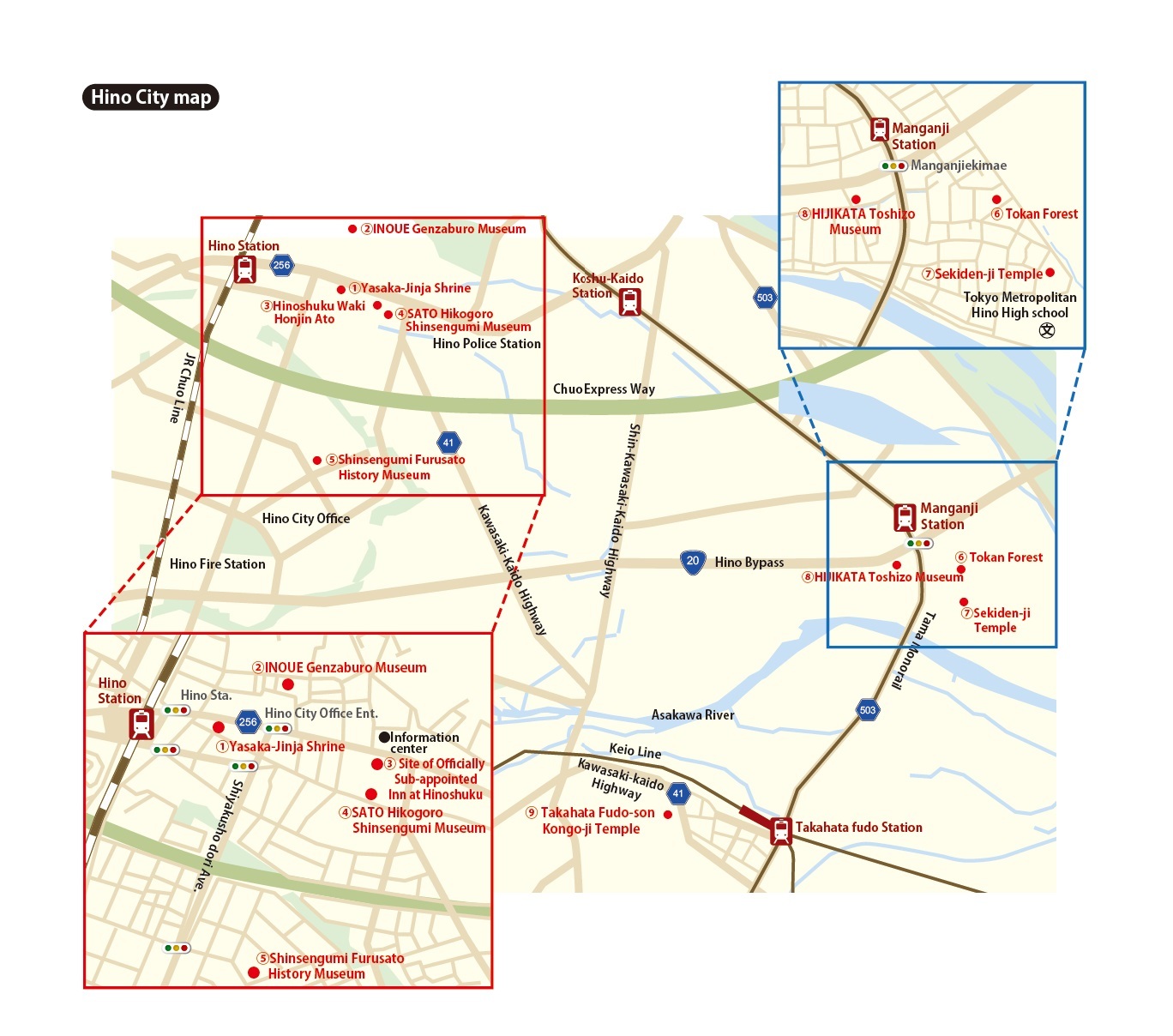
1 Main Hall of Yasaka-jinja Shrine
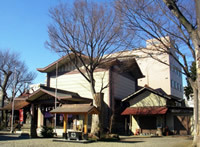
Main Hall of Yasaka-jinja Shrine
It was the So Chinju (the Grand Guardian Gods), also called Gozu-Tennosha Shrine. The Main Hall (Cultural property designated by Hino City), reconstructed in 1800, has the height of 9.1m, made of Zelkova, which was sculptured not only on veranda and walls, but also pillars, beams and balustrades. It is worth looking at.
This shrine has the Kegaku which were offered in 1858 by 23 members of Tennenrishin-ryu of Hinoshuku including SHIMAZAKI (KONDO) Isami, OKITA Sojiro (Soji), SATO Hikogoro, INOUE Matsugoro and Genzaburo. You can see this Kegaku in Shinsengumi Festival on May and in Reitaisai Festival on September.
Opening Information
- Open :
- All year
- Times :
- All day
- Fee :
- Free
Hino city Course (Let's take a stroll around The places associated with Shinsengumi !)
2 INOUE Genzaburo Museum
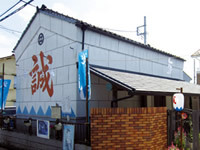
INOUE Genzaburo Museum
This museum is opened by INOUE Matsugoro and Genzaburo's family, using the warehouse of their birthplace.
There are valuable articles which shows the circumstances in Kyoto and Mibu-Roshigumi (later Shinsengumi) when Matsugoro went to Kyoto for attendant for Shogun Iemochi. Also they exhibit many articles concerned with Shinsengumi, Hachioji Sennin Doshin, and Tennenrishin-ryu.
Opening Information
- Open :
- 1st and 3rd Sundays
- Times :
- 12:00-16:00
- Fee :
- General : 500yen
junior high school and younger students : 300yen
Hino city Course (Let's take a stroll around The places associated with Shinsengumi !)
3 Site of Officially Sub-appointed Inn at Hinoshuku (Hino Post Town)
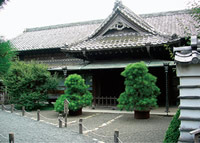
Site of Officially Sub-appointed Inn at Hinoshuku (Hino Post Town)
At the former Hinoshuku on Koshudo Highway, Honjin (officially appointed inn), and Waki Honjin (sub-honjin) were established side by side in the center of town. Daimyo (feudal lord), Hatamoto (lord of the Edo Shogunate), officials of Edo Shogunate stayed at Honjin, and Waki Honjin played a supplementary role. Honjin of Hinoshuku was residence of KAMISATO Family and Waki Honjin was those of SHIMOSATO Family, and both families served as headman of Hino Hongo and dealer of Hinoshuku. Although both Honjin and Waki Honjin burnt away in a great fire of 1849, Waki Honjin was reconstructed by SATO Hikogoro in 1864. It is the only Waki Honjin facilities which still remain without major alteration.
This building in gable roof with a traditional tiled roof is one of biggest buildings on Koshu-kaido Highway. It shows prestigious atmosphere with Shikidai entrance in Irimoya roof (gambrel roof) facing highway. However, SHIMOSATO Family had served as "Honjin" in a period of the late Edo period, so this building is designated as "Hinoshuku Honjin" Cultural property by Hino City.
SATO Hikogoro opened here the Tennenrishin-ryu Kenjutsu training hall, and HIJIKATA Toshizo, KONDO Isami and others gathering here, organized the Shinsengumi and worked actively.
Opening Information
- Open :
- All year (except Mondays (if a holiday falls on them, Tuesdays), the year's end and beginning)
- Times :
- 9:30-17:00 *Varies depending on the event
- Fee :
- General : 200yen
junior high school and younger students : 50yen
Hino city Course (Let's take a stroll around The places associated with Shinsengumi !)
4 SATO Hikogoro Shinsengumi Museum
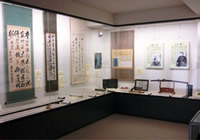
SATO Hikogoro Shinsengumi Museum
This museum is managed by the family of SATO Hikogoro, who was the headman of Hino Hongo and also a wholesale dealer at Hinoshuku. Hikogoro, who had opened the Tennenrishinryu school Kenjutsu training hall in a corner of his house, supported the members of Shinsengumi going to a trip from here. They exhibit many letters and articles concerned with Shinsengumi's members, and so you can see that they have strong ties.
Opening Information
- Open :
- 1st and 3rd Sundays
- Times :
- 11:00-16:00
- Fee :
- General : 500yen
junior high school and younger students : 300yen
Hino city Course (Let's take a stroll around The places associated with Shinsengumi !)
5 Shinsengumi Furusato History Museum

Shinsengumi Furusato History Museum

Exhibition room of Shinsengumi Furusato History Museum
The exhibit, which was opened in 2005, is on the theme of "Shinsengumi and Bakumatsu-Ishin (from the end of the Edo period through the Meiji Restoration)" and "Hinoshuku on the Koshudo Highway". For permanent exhibit "Shinsengumi, Shinchogumi and Hino" shows historical materials from the birth to the end of Shinsengumi. And special exhibitions are held. There is also a costume play corner to be a member of Shinsengumi.
Opening Information
- Open :
- All year (except Mondays (if a holiday falls on them, Tuesdays), the year's end and beginning)
- Times :
- 9:00-17:00
- Fee :
- General : 200yen
junior high school and younger students : 50yen
Hino city Course (Let's take a stroll around The places associated with Shinsengumi !)
6 Tokan Forest
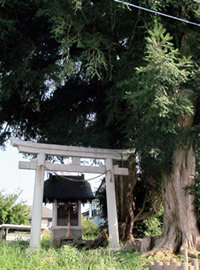
Tokan Forest
This green area has a small shrine of Inari used be surrounded with a lot of Torreya, Mukutree, Wisteria and Holly trees, in the current days those trees were felled by decline and death except for the two big Torreyas. This area is called "Tokan", which means that the Chinese character of inari can read phonetically "Toka", or the 10 (To in Japanese) families have taken care of the shrine.
HIJIKATA Toshizo's birthplace was near here. When his family's house was almost washed away by a flood in 1864, the people of Ishida village and others came up to help, and they took away the main house and warehouse to move the current place of the HIJIKATA Toshizo museum.
Opening Information
- Open :
- All year
- Times :
- All day
- Fee :
- Free
Hino city Course (Let's take a stroll around The places associated with Shinsengumi !)
7 Sekiden-ji Temple
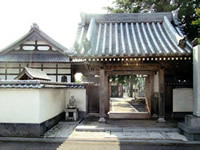
Sekiden-ji Temple
This temple of Shingon Sect is located where Tamagawa River and Asakawa River join together. According to the history of temple, this temple was founded in 1361, but it was dilapidated momentarily. Afterward this temple became to be called Sekiden-ji with a Kannon statue which came floating down Tamagawa River in flood in 1544. This episode shows the characteristic of this area which was rice-producing district but was menaced by flood.
Although HIJIKATA Toshizo's family temple is Takahatasan Kongo-ji Temple (Takahata Fudo-son), he was buried in this Sekiden-ji Temple. So not only on May 11, anniversary of his death, many his fans visit his grave.
Opening Information
- Open :
- All year
- Times :
- 9:00-17:00
- Fee :
- Free
Hino city Course (Let's take a stroll around The places associated with Shinsengumi !)
8 HIJIKATA Toshizo Museum
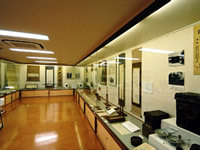
HIJIKATA Toshizo Museum
This museum on the site of HIJIKATA Toshizo's birthplace is managed by his family. They exhibit his born house reproduced in a model and 70 articles related to HIJIKATA including his helmet used in the Coupe of August 18 in 1863, and the habergeon used in the Ikedaya Incident, letters and so on.
Also, his favorite, "Izumi no Kami Kanesada" (Cultural Property designated by Hino City) which was forged in Kyoto in 1867, is exhibited here for a limited time.
Opening Information
- Open :
- 1st and 3rd Sundays
- Times :
- 12:00-16:00
- Fee :
- General : 500yen
junior high school and younger students : 300yen
Hino city Course (Let's take a stroll around The places associated with Shinsengumi !)
9 Takahata Fudo-son Temple
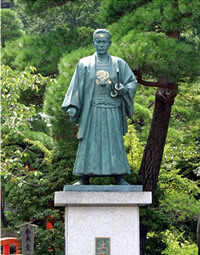
Statue of HIJIKATA Toshizo
Takahata-san Kongo-ji Temple, also called "Takahata Fudo-son", is one of the three biggest Fudo (Aclanatha, chief of the five great Myoo) temples in Kanto area, with Narita-san Shinsho-ji Temple in Chiba prefecture. The temple is also known as a family temple of HIJIKATA Toshizo. There is a monument of HIJIKATA Toshizo and KONDO Isami, and the temple keeps HIJIKATA's mortuary tablet and letters, and some other documents about Shinsengumi.
The temple is very old and said to have built before the Taiho era (701-704) or to have founded by monk Zikaku (794-864). The temple has been formed into a large-scale temple in the late Heian period at the latest.
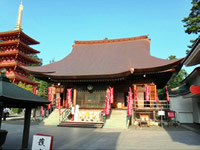
Fudo-do Hall of Kongo-ji Temple (Courtesy of the Japanese Association for conservation of Architectural Monuments)
Fudo-do hall of Kongo-ji Temple
National Cultural Important Properties (Buildings)
Designated on November 29, 1946
Fudo-do Hall of Kongo-ji Temple is a magnificent building and has 5 ken (a Japanese old unit of the length meaning distance between the two pillars) in both width and depth at the beam. According to the inscription on the back of Honzon Fudo Myoo-zo Kohai (flame-shaped halo of the statue of Fudo Myoo), originally located in mountain. Fudo-do Hall was destroyed by a big storm and reconstructed at the present place in 1342. So we have a possibility to remain and still use some materials made in Koei era (1342-45). The inside of the hall is filled with smoke and dark, people usually make a fire in this hall for Goma training, which shows an atmosphere of typical medieval esoteric Buddhism style. The gracefully curved roof and deep eaves are also characteristics.
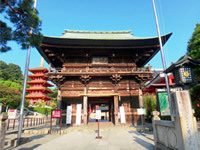
Nio-mon Gate of Kongo-ji Temple (Courtesy of the Japanese Association for conservation of Architectural Monuments)
Nio-mon Gate of Kongo-ji Temple
National Cultural Important Properties (Buildings)
Designated on November 29, 1946
Nio-mon Gate of the temple has 3-ken and 1 door of the Ro-mon Style, seems to be constructed in the late Muromachi period, also the statues of Nio-zo set in the Gate seems to be built in Muromach period. By the repairment of the Gate in 1959, we found the evidence to be originally 2 stories, not to be 1 story that built in the Edo period. So the Gate is restored to the original state of 1 story now.
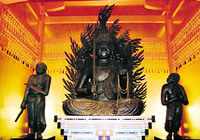
Wooden Statue of Fudo Myoo flanked by Two Youths Attendants
Wooden Statue of Fudo Myoo flanked by Two Youths Attendants
National Cultural Important Properties (Sculptures)
Designated on June 28, 1994
The Statue of Fudo Myoo installed in the posterior hall of Kongo-ji Temple by the triad style which brought Kongara-doji (the youth of Kongara) on the right of Fudo Myoo and Seitakadoji (the youth Seitaka) on the left. The Kongara and Seitaka are both originally in Sanskrit and mean attendant.
These statues seem to create in the late Heian period (11-12 century). The inscription on the halo of Fudo Myoo says that they had been damaged by the gale and repaired in the Nanbokucho period (1336-92).
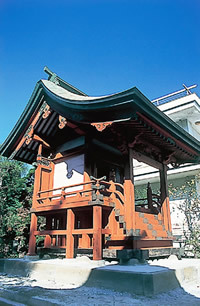
Former Five- Gongen Hall of Kongo -ji Temple
Former Five- Gongen Hall of Kongo -ji Temple
Tangible Cultural Properties of Tokyo (Buildings)
Designated on February 13, 1960
Kongo-ji Kyu Gobugongen Shaden (Former Five- Gongen Hall of Kongo-ji Temple) was founded as a guardian deity of Kongo-ji Temple, which can be found on "Shinpen Musashi Fudokiko" (topography of Musashi Province in 1804-29), and the building is located in the depth of temple precinct. According to the legend of the temple, MINAMOTO no Yoriyoshi contributed to building a Hachiman-sha Shrine, after that enshrined together with the deities, Inari, Nyu, Koya and Seiryu Gongen, and became Gobu-gongen (5 deities). There five tablets enshrined at the shrine were inscribed with deities' names and the construction date, February 28th 1340. They are resistrated as National Important Arts.
The ridge tag tells that the present building was founded in 1340 and rebuilt in 1671. This building is important, as a rare example, having the evidence of existent in the early Edo period.
This building is 1.52m wide, and 1.30m deep at the beam with a copper sheet roof and a Kohai (step canopy, visitors face the main hall and worship under it). It is lacquered in vermilion, carvings are emphasized with ink and Kaerumata (strut looks like frog legs) of the step canopy are colored with ultramarine blue.
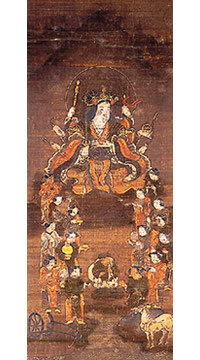
Goddess Benzaiten with 15 servants, Color painting on silk
Goddess Benzaiten with 15 servants, Color painting on silk
Tangible Cultural Properties of Hino City (Paintings)
Designated on February 22, 1988
Benzaiten (Saraswati), one of the Seven Deities of Good Fortune, honored by the water as Goddess of River, is popularly worshipped.
In this painting, Benzaiten is set on the center of the screen, and 15 servants line up in the below with two lines, and a Daikokuten with hood and moustache is set at the bottom center.
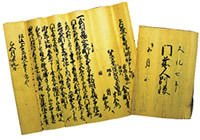
Archives of Takahata-san Kongo-ji Temple
Archives of Takahata-san Kongo-ji Temple
Tangible Cultural Properties of Tokyo (Old Documents)
Designated on March 6, 2000
Archives of Takahata-san Kongo-ji Temple consists of 4110 documents of the temple. They show not only the history, constructions and donation of the temple, but also political and social conditions, for example Sakurada incident, and the trends around the temple in the end of Edo period.
They have important historical value especially as the collective archives from the early Edo period to the early Showa period, which help us to know details of the temple's history and their social situation.
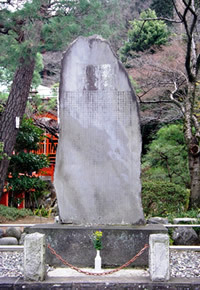
Monument of Two Great Martyrs
Monument of Two Great Martyrs
Historic Site of Hino City
Designated on October 1, 1961
This is a monument of honor for KONDO Isami and HIJIKATA Toshizo. Their family members and supporters including SATO Toshimasa (Hikogoro) had planned to erect a monument since 1876, however they couldn't easily obtain permission of the Governor of Kanagawa Prefecture, and at last it was built in 1888. On this monument, heroic deeds of these two heroes in Chinese writing were engraved, the writing by MATSUDAIRA Katamori (feudal lord of Aizu Domain) in characters used on seals, a composition by OTSUKI Bankei (a Confucian of Sendai Domain) and the writing by MATSUMOTO Jun (a doctor, who worked for the Shogunate)
Opening Information
- Open :
- All year
- Times :
- 9:00-17:00
- Fee :
- Free
Chofu City, Mitaka City Course (Let's take a stroll around The places associated with Shinsengumi !)
Memories of Shinsengumi in Chofu City and Mitaka City
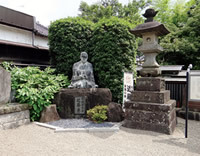
Seated statue of KONDO Isami (Saiko-ji Temple)
KONDO Isami, the chief of Shinsengumi, was born as the third son of a wealthy farmer called MIYAGAWA Kyujiro. When he was 15 years old, he became a disciple of Tennenrishin-ryu School, directed by KONDO Shusuke, with his elder brother. And next year, he was adopted by Shusuke having been recognized for his talent. When he was 28 years old in 1861, he succeeded to the 4th head of Tennenrishin-ryu and held on the demonstration play at the Rokushogu Shrine.
In 1863, KONDO Isami joined Roshigumi which was organized for the guard of the 14th Shogun TOKUGAWA Iemochi's visit to Kyoto, with HIJIKATA Toshizo and YAMANAMI Keisuke and other disciples. Although many Roshi (masterless samurai) returned to Edo, KONDO Isami was left to be in charge of maintaining security of Kyoto City. It is well known that they were gained fames in Ikedaya Incident and others, and in 1867 he became Bakushin (shogun's retainer).
On January in 1868, after defeat at the Battle of Toba-Fushimi, he returned to Edo and organized the Koyo Chinbutai. On March they prayed to Kamiishiwara Wakamiya Hachimanjinja Shrine (3 Shimoishiwara, Chofu City) from the distant for the war's victory. The seated statue of KONDO Isami which was produced by local research organization of Shinsengumi, called "KONDO Isami-to Shinsengumi-no-Kai (Organization of KONDO Isami and Shinsengumi lovers)", is placed beside of Sanmon Gate (temple gate) of Saiko-ji Temple. After that the Koyo Chinbutai fought against the Army of the New Government, KONDO Isami surrendered to them and was executed at Itabashi, Edo City, at 35 years old. His nephew KONDO Yugoro buried him at Ryugen-ji Temple (6 Osawa, Mitaka City) located near his birthplace. At the graveyard of KONDO Family in Ryugen-ji Temple, there are graves of his step-brother KONDO Yugoro and his son, Kyugoro.
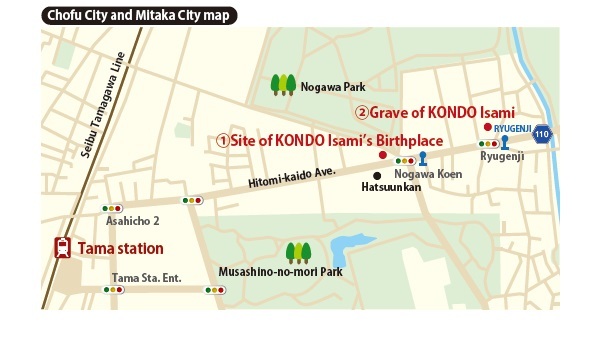
1 Site of KONDO Isami's Birthplace
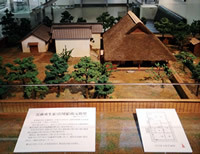
Reconstructed model of KONDO Isami's Birthplace
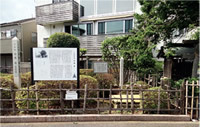
Site of KONDO Isami's Birthplace (Saiko-ji Temple)
KONDO Isami was born into MIYAGAWA Family, and their house stood at the crossroads of Hitomi-kaido Street and the street leading to Koganei, about 2.4 km north of Kamiishiwarajuku on Koshu-kaido Avenue. It has the main house, warehouse, private library, and barn in a total 7,000m². In the garden there were artificial hill and planted Zelkova and Oak around the house, Bamboo in back of a house. KONDO Isami's father MIYAGAWA Kyujiro, wealthy farmer, invited KONDO Shusuke, head of the Tennenrishin-ryu School, and provided the barn as Kenjutsu training hall. After Isami was adopted by Shusuke, this Kenjutsu training hall was so crowded with disciples.
In 1943, this house was destroyed because it disturbed fighter plane flying away from the Chofu Military Airport. Only a well, has been remained, which has been said that water of it was used for Isami's first bath when he was born. The Chofu Folk Museum exhibits the model of birthplace (scale 1:300,000) which was reproduced in collaboration with MIYAGAWA Family.
There is Kondo-jinja Shrine adjacent to the well, which was built by soldiers in Tokyo area in 1926. Also in front of this shrine, Kenjutsu training hall of the Tennenrishin-ryu School "Hatsuunkan" is located. "Hatsuunkan" opened in 1876 by Yugoro, Isami's son-in-law, has been said that it was named and calligraphed the signboard by YAMAOKA Tesshu.
Opening Information
- Open :
- All year
- Times :
- All day
- Fee :
- Free
Chofu City, Mitaka City Course (Let's take a stroll around The places associated with Shinsengumi !)
2 Grave of KONDO Isami
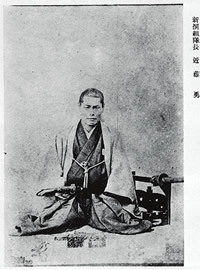
KONDO Isami (Courtesy of National Diet Library)
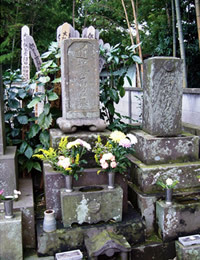
Grave of KONDO Isami
The grave of KONDO Isami is located in Osawazan Ryugenji Temple, in Osawa, Mitaka City, which is on Hitomi-kaido Avenue, 1km east from Tama Station of SeibuTamagawa Line. In front of the temple gate, there is a bust of KONDO Isami with Roku Jizo (six Ksitigarbhas) and Koshinto pagoda, and the KONDO Family's graveyard is in back of the Main hall. He was active as the chief of Shinsengumi and became Bakushin (shogun's retainer) from a farmer, however he caught by the Army of the New Government and executed at Itabashi.
His nephew KONDO Yugoro buried him at Ryugen-ji Temple located near his birthplace.
In this graveyard, there is his grave among 5 graves of his family. On this grave in thin and narrow cubic shape, inscription of "grave of KONDO Isami" was engraved. There is also a stone monument with his death haiku and putting on a notebook with words and illustrations of praise by his fans, from which we can still know his popularity not to decline.
Opening Information
- Open :
- All year
- Times :
- between sunrise and sunset
- Fee :
- Free
Fuchu City Course (Let's take a stroll around The places associated with Shinsengumi !)
Memories of Shinsengumi in Fuchu City
A famous Japanese novel, "Moeyo Ken" by SHIBA Ryotaro, which is about the life of HIJIKATA Toshizo, starts with the festival of this Okunitama-jinja Shrine. Also KONDO Isami succeeded to the 4th master of Tennnen Rishin Ryu School (a school of swordplay) and his demonstrated match was held on this shrine in 1861.
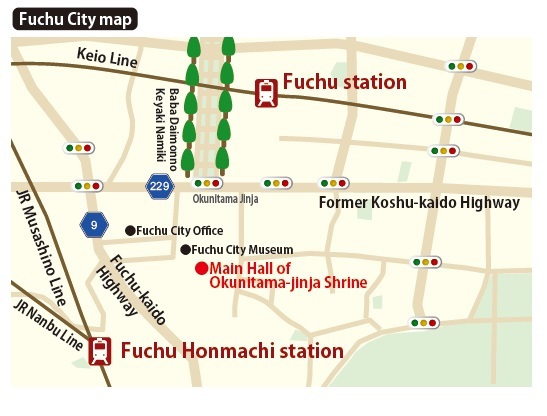
1 Main Hall of Okunitama-jinja Shrine
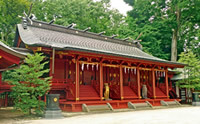
Main Hall ofOkunitama-jinja Shrine
Okunitama-jinja Shrine used to be called "Rokusho-gu" (6shrines), and worshiped as a guardian deity of Musashi Province.
In order to enshrine nine gods included with Okunitama no Okami, six kami (gods) and so on, the main hall of the Okunitama-jinja Shrine is wide and unique, which is jointed the three of buildings with San (3)-gensha Nagare Style (an architecture style of three-bay wide structure with a gable roof), so-called Kyu(9)-kensha Nagare Style or Aidono Style. Now, Okunitama no Okami is enshrined in the central building, other 6 gods are in the east and west.
However, the map of 1606 shows the individual three main buildings, and another record said these buildings were destroyed by the fire in 1646. We consider that the buildings were reconstructed in this present style after the fire. The total length of ridge is about 14m and the height reaches about 9m, vermillionlacquered. The roof had been covered with Hiwadabuki(cypress bark roof) before, and have changed into the copperplate at the end of the Edo period.
These buildings are also a precious example of construction ordered by Shogunate.
Opening Information
- Open :
- All year (Allowed to look at only the exterior)
- Times :
- All day (Allowed to look at only the exterior)
- Fee :
- Free
Machida City Course (Let's take a stroll around The places associated with Shinsengumi !)
Memories of Shinsengumi in Machida City
KOJIMA Shikanosuke, the headman of Onoji-mura Village at the end of Edo period, became a disciple of Tennenrishin-ryu School the third leader KONDO Shusuke. KONDO Isami who succeeded to Shusuke, taught Kenjutsu at the training hall in KOJIMA Family's house. Shikanosuke took a pledge of brotherhood with KONDO Isami and SATO Hikogoro, headman of Hinoshuku, and supported Shinsengumi. So, many letters and articles concerned with Shinsengumi remain at KOJIMA Family.
1 KOJIMA Museum
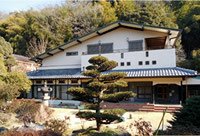
KOJIMA Museum
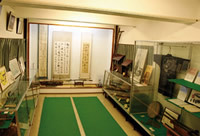
Exhibition room of KOJIMA Museum
KOJIMA Museum, using thatched house of headman in the Tenpo Era (1830-1843) remodeled in 1968, was opened as private museum. This museum has valuable collections including articles of Shinsengumi, "Archives of KOJIMA Family, Former Tama country Onoji Village" designated by Tokyo as Tangible Cultural Property (Ancient Documents)," Reference Materials related to army of Farmers conscripted from Onoji" designated by Tokyo as Tangible Cultural Property (Historical Resources) and etc.
In Onojimachi, Machida City, located 3km far from Tama-Center Station, escaped from development of New Town, there remains Onojijuku and Satoyama (outskirt of country), so many people visit here to enjoy taking a stroll.
Location : 950 Onoji, Machida city
Transportation Facilities : From Tsurukawa Station on Odakyu Tama Line, take the bus bound for Tama Center via Onoji, get off at Ono-jinja mae stop and walk one minute / from Tama Center Station on Keio Sagamihara Line, Odakyu Tama Line or Tama Monorail, take the bus bound for Tsurukawa Station via Onoji, get off at Onoji-jinja mae stop and walk one minute
Opening Information
- Open :
- 1st and 3rd Sundays (except January and February)
- Times :
- 13:00-17:00
- Fee :
- General : 600yen
junior high school and younger students : 300yen
Tokyo Cultural Heritage Map
Would you like to go around cultural heritages? In Tokyo, there are various cultural heritages. This map helps you go around cultural heritages with efficiency during limited time in your trip. Japanese traditional temples and shrines, the cultural heritages concerned to most famous events and person in Japan and a lot of nature. This map introduces all of them widely! You must watch them and know the history and the culture of Tokyo!

SNS




